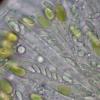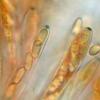
04-01-2026 17:45
 Stephen Martin Mifsud
Stephen Martin Mifsud
I was happy to find these orange asmocyetes which

03-01-2026 13:08
Niek SchrierHi all,We found groups of perithecia on a Lecanora

29-12-2025 17:44
Isabelle CharissouBonjour,J'aimerais savoir si d'autres personnes au

02-01-2026 17:43
MARICEL PATINOHi there, although I couldn't see the fruitbody, I

01-01-2026 18:35
Original loamy soil aside a artificial lake.The co

31-12-2025 19:27
Collected from loamy soil, at waterside (completel
Two ascus & spores in Trochila laurocerasi
Michel Hairaud,
31-07-2011 10:18
 Hi to everyone , Bonjour à tous,
Hi to everyone , Bonjour à tous, Trochila laurocerasi is a common species (everywhere ?) .
I am puzzled in finding 2 types of ascus and spores as seen in the following pictures.
Normal spores are largely fusiform, biguttulate, ca 11x4 µm
Other spores eguttulate, clavate, shorter , ca 8x 3 µm
Ascus are also shorter in the 2nd form : 58-59 x 5-7,5 instead of 70-75 x 9 in the normal one.
Iki reaction is, as seen here, the same.
I do not feel that this difference is due to unmaturity .
Has someone an explanation ?
Amitiés
Michel
Luc Bailly,
31-07-2011 10:47
Re : Two ascus & spores in Trochila laurocerasi
Bonjour Michel,
J'ai déjà observé cela pour Trochila craterium: quand les apothécies ne sont pas tout à fait mûres, les spores sont plus petites.
Je dois fouiller dans mes notes des années précédentes, je regarderai si j'ai toujous les mesures de plusieurs récoltes.
Je ne me rappelle pas avoir vu ce phénomène dans des asques différentes de la même apothécie comme illustré ici, mais je regarderai. Il y a toujours des asques à différents stades.
Dès que j'en ai de nouvelles récoltes.
Je n'ai pas de station de T. laurocerasi hélàs...
Amitiés - LUC.
J'ai déjà observé cela pour Trochila craterium: quand les apothécies ne sont pas tout à fait mûres, les spores sont plus petites.
Je dois fouiller dans mes notes des années précédentes, je regarderai si j'ai toujous les mesures de plusieurs récoltes.
Je ne me rappelle pas avoir vu ce phénomène dans des asques différentes de la même apothécie comme illustré ici, mais je regarderai. Il y a toujours des asques à différents stades.
Dès que j'en ai de nouvelles récoltes.
Je n'ai pas de station de T. laurocerasi hélàs...
Amitiés - LUC.
Hans-Otto Baral,
31-07-2011 12:24

Re : Two ascus & spores in Trochila laurocerasi
Hi Michel and Luc
That's easily explained: the smaller spore are the dead ones in which the LBs are hardly seen anymore. You can see on your photos that these small spores are only inside dead asci. You can make the test: add KOH, then the LBs will be visible again, but the difference between large and small will vanish.
I found this species in my village, but it's long ago, so I did not have any photos. Thanks!
Zotto
That's easily explained: the smaller spore are the dead ones in which the LBs are hardly seen anymore. You can see on your photos that these small spores are only inside dead asci. You can make the test: add KOH, then the LBs will be visible again, but the difference between large and small will vanish.
I found this species in my village, but it's long ago, so I did not have any photos. Thanks!
Zotto
Stip Helleman,
31-07-2011 23:07
Hans-Otto Baral,
31-07-2011 23:24

Re : Two ascus & spores in Trochila laurocerasi
Hi Stip
yes, that is a common phenomenon, especially with free spores. But on Michel's photo I faintly see the oil drops and predict that they reappear when you add KOH. When melted together, then the individual LBs are irreversibly lost.
Zotto
yes, that is a common phenomenon, especially with free spores. But on Michel's photo I faintly see the oil drops and predict that they reappear when you add KOH. When melted together, then the individual LBs are irreversibly lost.
Zotto
Stip Helleman,
31-07-2011 23:37

Re : Two ascus & spores in Trochila laurocerasi
Hi Zotto,
Yes i saw that vague regions also in some spores but interpreted that as a empty region inside the LBs (perhaps the Necleus) they are less refractive as the LBs.
So Michel, there is work to do we would like to see it in KOH
Amitiés
Stip
Michel Hairaud,
01-08-2011 00:11

Re : Two ascus & spores in Trochila laurocerasi
Hi friends, thank you for the kind support to my shrinking .... neuron !
Yes I easily think you might be right.
KOH (3%)does not make the bodies reappear as if they had melted .
KOH provokes shrinkage and lipid guttules melting inside the normal spores , but for a narrow ''septum'' which remains between the two halves , which is not the case in the other spores.
I could not check Stip's observation on the spore wall. In my case the vb seems to fill totally the spore. (After shriinkage ?)
Amitiés
Michel
Yes I easily think you might be right.
KOH (3%)does not make the bodies reappear as if they had melted .
KOH provokes shrinkage and lipid guttules melting inside the normal spores , but for a narrow ''septum'' which remains between the two halves , which is not the case in the other spores.
I could not check Stip's observation on the spore wall. In my case the vb seems to fill totally the spore. (After shriinkage ?)
Amitiés
Michel
Stip Helleman,
01-08-2011 00:18

Re : Two ascus & spores in Trochila laurocerasi
Hi Michel,
you are a rising star!
thanks for sharing your observations, mine were in water mount probably there the sporewall did not shrink that much.
Amitiés
Stip
you are a rising star!
thanks for sharing your observations, mine were in water mount probably there the sporewall did not shrink that much.
Amitiés
Stip
Michel Hairaud,
01-08-2011 00:33

Re : Two ascus & spores in Trochila laurocerasi
Hi Stip !
A la demande générale... voici une photo dans la potasse.
Excuse me for the bad quality of the picture but it shows that there is no change in KOH for the smaller spores .
I must add that this experiment was made after rehydratation of the substrate (but the normal spores appeared as large and guttulate as before dessication)
Good night from the rising star.
Michel
A la demande générale... voici une photo dans la potasse.
Excuse me for the bad quality of the picture but it shows that there is no change in KOH for the smaller spores .
I must add that this experiment was made after rehydratation of the substrate (but the normal spores appeared as large and guttulate as before dessication)
Good night from the rising star.
Michel
Hans-Otto Baral,
01-08-2011 12:17

Re : Two ascus & spores in Trochila laurocerasi
Yes Michel, you have won. The small spores still look as if without guttules. Maybe the lipid has merged as Stip said. The large spores are now smaller, and I do not recognize a difference in size anymore. Of course all asci are now shrunken. So this illustrates how difficult it is to show lipid bodies in dead material, even in KOH.
Zotto
Zotto








